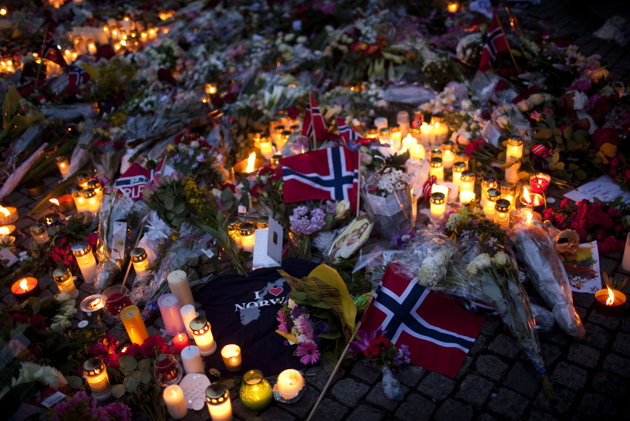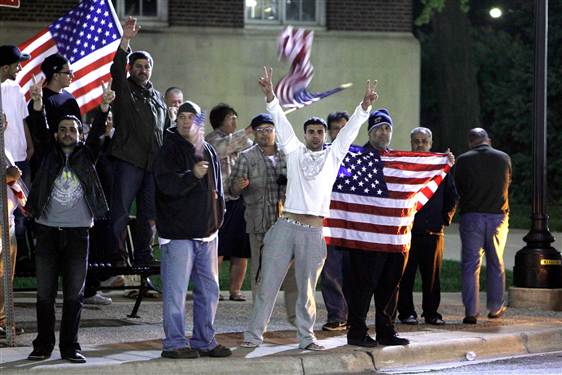Boston Marathon Bombing: Feds Raid Apartment, Police Seek Rental Van
Federal authorities late Monday removed several bags from an apartment in a nearby suburb. Police investigating the Boston Marathon bombing have also issued an alert for a rental van and for a hooded man who left the area before the blasts.
By Peter Grier | Christian Science Monitor

Boston was battered but vigilant on Tuesday as an army of federal agents raced to find out who attacked the city’s historic marathon, leaving three dead and more than 100 injured amid a war zone of shattered glass and bomb debris on Patriots Day.
As of Tuesday morning, no persons or group had claimed credit for twin explosions at the finish line near Boston’s Copley Square. The Pakistani Taliban, a group that has threatened the United States in the past, denied participation, according to the Associated Press.
Law enforcement officials questioned an injured Saudi national at a local hospital, but news stories indicated that the individual appears to have no connection to the case. The Boston Globe reported that he was simply a frightened spectator who had tried to flee but was tackled and restrained by bystanders.
On Monday night agents from the FBI, the Bureau of Alcohol, Tobacco, Firearms, and Explosives (ATF), and other law enforcement agencies raided a unit in a high-rise apartment on Ocean Drive in the seaside Boston suburb of Revere, according to information posted online by a participating local fire department. Several bags, including what appeared to be a large duffel bag, were removed from the scene. Authorities were mum as to the specifics of their suspicions but confirmed that the Revere search was related to the case.
Rep. William Keating (D) of Massachusetts, a member of the House Homeland Security Committee, told a local CBS reporter that the two bombs at the finish line, which exploded seconds apart, had been stashed in trash receptacles and were clearly a “coordinated attack.” Authorities have discovered two other unexploded devices, he told Boston’s WBZ News.
Other reports said no unexploded devices had been found. A reported fire at Boston’s John F. Kennedy Presidential Library turned out to be the result of an electrical problem and was unrelated to the marathon bombs, according to Boston police.
NBC News reported that the explosive devices near the finish line had been packed with ball bearings to enhance their lethality. Doctors treating some of the 126 wounded at local hospitals said many had been hurt by metal shrapnel, though they added it was unclear whether the metal in question had simply been part of the environment or was the result of a shredded trash receptacle.
Police have issued an alert for a rental van that may have tried to gain access to the finish line area and for a man in dark clothing and a hood seen leaving the scene shortly before the blast, reported NBC. Surveillance video shows a hooded figure carrying two backpacks at about that time.
Among the dead is 8-year-old Martin Richard, whose father was running in the race. The boy’s mother and sister were also gravely injured, according to a Boston Globe report. The family had gathered at the finish line for cheers and celebrations.
Although President Obama did not use the word “terrorism” in remarks to the nation Monday evening, other US officials made it clear that the bombing is being treated as a terrorist attack. That would make it the first such strike on US soil since Sept. 11, 2001, and a deadly reminder that it is impossible to armor all national activities against a terrorist threat.
One thing is clear: The bomber or bombers were not highly skilled. The explosive devices were relatively crude compared with those produced overseas by Al Qaeda or other radical Islamist terrorist groups, RAND Corp. terror expert Brian Jenkins told Los Angeles television. They were much smaller than the powerful truck bomb that Timothy McVeigh used to devastate the federal building in Oklahoma City in April 1995.
In that sense they were analogous to the pipe bombs that killed two and injured 100 in 1996 at Atlanta’s Centennial Park during the Olympics.
The fact that the target was an event of great significance to Boston but not particularly significant to the wider world could indicate that the bomber was a local or at least a native of the United States. The explosions occurred on April 15, tax day, which could be a further indication of a domestic connection.
But the bombs were not directed against a government building or institution, which is often a hallmark of disaffected, lone-wolf domestic terrorists, noted some terrorism analysts. And the style of the attack, in which one explosion was closely followed by another, mimics that used by numerous groups in the Middle East.
One government official told the Los Angeles Times that his guess would be “self-radicalized Islamic extremists from the area.”
Meanwhile, a large area of Back Bay Boston remained sealed off as an enormous outdoor crime scene. Police were working their way through a mountain of bags and other debris left by the fleeing crowd in an effort to ensure that no further explosives will detonate. Cities across the US tightened security, just in case – New York City dispatched police critical response teams to guard sensitive sights, while in Washington the Secret Service expanded the security perimeter around the White House.
In London, authorities were reviewing security plans for Sunday’s London Marathon, the next such major international race.
Related stories
- Quiz: How much do you know about terrorism?
- Boston Marathon bombings: What could the motives have been?
- Comforting Boston
JYJFantalk Source: yahoo news+Christian Science Monitor
Picture Credit: yahoo news
Share This


